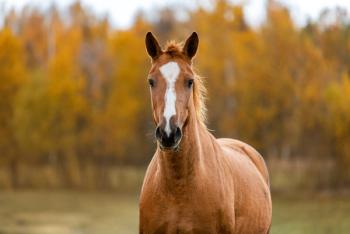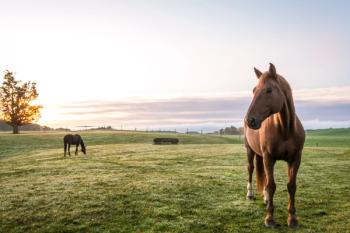
Saving Barbaro
From the time his experienced jockey, Edgar Prado, gently pulled him up and kept him quiet while veterinary assistance arrived until this very day, Barbaro's new battle has been one of a convergence of fate, veterinary excellence and most of all, teamwork.
From the time his experienced jockey, Edgar Prado, gently pulled him up and kept him quiet while veterinary assistance arrived until this very day, Barbaro's new battle has been one of a convergence of fate, veterinary excellence and most of all, teamwork.
Barbaro is lowered into a pool recovery system that helps protect orthopedic repairs while waking up from anesthesia.
"I would call Prado, the first responder," says Scott Palmer, VMD, Dipl. AVBP, proprietor of New Jersey Equine Clinic. He was at Pimlico as a spectator, but he soon joined the huddle on the track. "He managed that horse as good as anyone could. He did a great job in controlling him."
It was important, too, that Pimlico had an excellent horse ambulance and crew. Barbaro was well cared for by them and the emergency veterinary crew at the racetrack, Palmer says. The ambulance floor lowered hydraulically so the horse didn't need to go up a ramp, and its squeeze-chute allowed the horse to be supported in the stall.
"Years ago, you might have had to load him in a horse trailer, which might have risked further injury," Palmer says.
Dr. Dean Richardson examines Barbaro's leg the day after his surgery.
Once back at his stall, a digital X-ray machine was set up, so the horse didn't have to move again to be filmed. On physical exam, they assessed the skin to see that it was intact, and indeed it was, which was hopeful. The use of digital radiography sped up the diagnostic process considerably and allowed for immediate interpretation of the films. The fractures were diagnosed in minutes.
"He had shattered his pastern, but it was quite surprising to see he had the condylar fracture of the cannon bone, as well. With those two things, we were trying to think of the way we were going to get the fracture together because the word 'euthanasia' never entered any of our thoughts," says Dr. Nick Meittinis, Pimlico's attending veterinarian.
The diagnosis was delivered to trainer Michael Matz and Barbaro's owners.
Once it was decided that Barbaro was a surgical candidate, they tried to assess his blood flow to the lower limb. He did not have a great pulse at the time of exam. With the fracture and a lot of peripheral bleeding under the skin, he was probably in a certain degree of shock, which would make his pulse a little thready. With those two things going against them, there was a third. When he shattered P1, he didn't leave an intact strut, a continuous piece bone from the cannon down the middle of the pastern. The major concern was how a surgeon would be able to get it together.
Racing injuries
"From that point on we knew he would have to go to Dean (Richardson, chief of surgery and the Charles W. Raker Professor of Equine Surgery at Penn's Widener Hospital at New Bolton Center), but whether he was going to survive and whether Dean could put it together, wasn't really our concern, but only whether we could get him there," Meittinis says.
They put a four-layer Robert Jones bandage on him, a pressure bandage, applied two layers of padding and a tight wrap. They created a tube, with the hoof, the pastern, and the cannon bone, in a straight extension inside it. Three quarters through the Robert Jones bandage, they integrated the Kimzey splint for added stability. Therefore the leg would stay in extension and he could use the Kimzey and the bandage as some support during the two and a half-hour van ride to New Bolton. They also narrowed the stall within the ambulance so he could lean.
"There is no one star in this picture," says Meittinis, "from Jamie Richardson (track superintendent) to Joe Miller, who drove the van, and the entire crew, which also included Drs. Dan Dreyfuss and Rachel Beard, both with the Pimlico veterinary staff, as well as Palmer. While Beard was holding the horse's leg as I was putting on the bandage, in comes Scott Palmer. It was organized and controlled. We got the horse to New Bolton in the same shape he left in. That was our goal."
Radiographs before and after surgery. Note the locking compression plate, which allows screws to be driven through it, an innovation for very unstable injuries.
Hours of complicated surgery
It was Barbara Dallap, VMD, Dipl. ACVS, ACVECC, assistant professor of emergency medicine/critical care, who admitted Barbaro while Dr. Dean Richardson returned from a surgery in Florida. But Richardson was able to access the digital radiographs via e-mail.
From a critical-care standpoint, New Bolton has three double-boarded clinicians, totally devoted to admit emergencies. The main determination was whether Barbaro was a healthy patient with a bad injury, or a badly injured patient with significant additional other problems. It was determined that he was in good physical shape; he seemed to be handling things pretty well, and going into surgery and coming out of anesthesia these were the primary emergency and critical-care concerns.
Dallap inserted an intravenous catheter to make sure he was hydrated, with appropriate blood volume and adequate perfusion. They also ran some blood work to make sure everything was normal, which it was, and adjusted the leg splint so he wouldn't hurt himself lying down and getting up during the night.
Richardson notes that the surgery was sort of a combination of a bunch of techniques that have been around for a while, though they are usually used for individual repairs.
During the surgery, the fetlock joint and the pastern joint were fused to give the leg as much stability as possible.
Dallap says today they have a better ability to monitor patients while under anesthesia than they used to, with better drugs and intravenous infusion, so the amount of inhalant used is quite a bit less than in years past. Induction of anesthesia is also improved. Rather than have the animal collapse in a heap, they suspend him in a sling, for support, which facilitates getting him to the table safely. Penn's pool recovery system helped protect the orthopedic repair during the process of the animal waking up from anesthesia, which is critically important with horses, especially with hind-limb injuries. After surgery, they tend to have more catastrophic failure with hind-limb injuries than with fore limb injuries, and the pool is definitely an advantage compared to 20 years ago.
Richardson repaired the fracture with a locking compression plate (LCP). This plate, available commercially for about two years, is potentially better for very unstable injuries like Barbaro's. According to Richardson, it is an improved design for this type of very unstable fracture. Though not needed for every kind of injury, it has significant advantages and should help quite a bit on such unstable injuries.
With the locking plate system, the head of each screw can be threaded directly into the plate. This results in a more stable fixation than traditional plate fixation in which the screws provide stability only by their ability to compress the plate against the surface of the bone. With the locking plate, the fixed angle of the screw within the plate provides stability even when the reconstruction of the bone fragments and the position of the plate up against the bone are not perfect.
"The surgery was a masterpiece from an orthopedic point of view," says Patty Hogan, VMD, Dipl. ACVS, veterinary orthopedic surgeon at New Jersey Equine Clinic and a former student of Richardson. "He put those fractures together as best as it possibly could be done."
Richardson is a bit more modest: "I've had a great opportunity to be in a position where I've been around a place to try different techniques, to use different materials. Working at New Bolton Center, you get the opportunity to try very difficult cases, and if you don't get to try, then you don't have a chance to succeed or advance the field."
Newsletter
From exam room tips to practice management insights, get trusted veterinary news delivered straight to your inbox—subscribe to dvm360.




